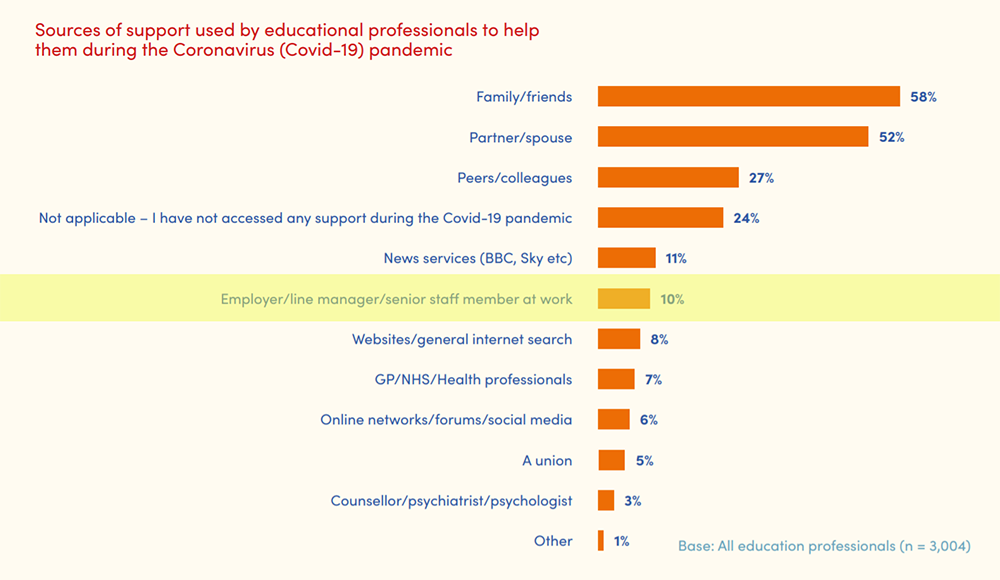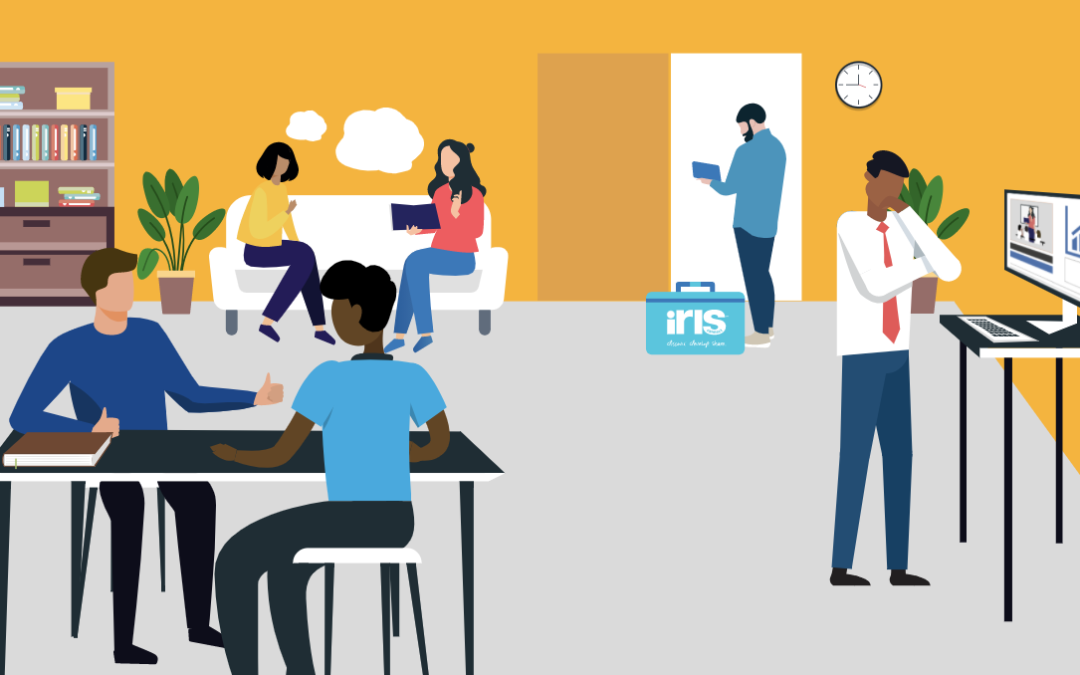The UK Teacher Wellbeing Index of 2019 stated that more than half (57%) of all staff had considered leaving the sector in the past two years because of health pressures and, of those who had considered leaving, stress was an issue. In The Teaching and Learning International Survey 2018, Australian Report Volume 2: Teachers and School Leaders as Valued Professionals, almost a quarter of teachers reported experiencing a lot of stress in their work and those who reported greater stress are more likely than colleagues with lower levels of stress to leave the profession in the next five years. What is frightening is these results came out before the pandemic.
It’s ironic and somewhat shameful that wellbeing is driving so many great teachers from the profession, when research has shown teacher wellbeing and pupil outcomes to be intrinsically linked, and that the number one reason for entering teaching is the belief that positive change can be affected on young people’s lives.
Because many of the factors threatening teacher wellbeing are institutional, reminding teachers to get 8 hours of sleep, eat healthily, exercise at least twice a week, moderate their caffeine and alcohol intake or practice mindfulness can be a little patronising. Yes, these are all scientifically proven to support mental and emotional wellbeing, but a) your teachers probably don’t need you to remind them and b) this kind of advice often ignores the factors creating poor teacher wellbeing in the first place.
Teacher workload and stress
When looking at ways to improve teacher wellbeing, we therefore first need to explore the different parts of it.
Wellbeing is much more than happiness. While it does include happiness, it also includes other things, such as how satisfied you are with your life, your sense of purpose, and how in control you feel. Given the current circumstances, it’s not at all surprising a lot of people are struggling with this.
In a recent report from Education Support, 52% of UK education professionals say their mental health has declined during the global pandemic with many citing increases in workload, concerns for their own, and their students’ mental health, and poor work-life balance as the causes.
Effects of teacher stress on students
It’s also important to consider the impact this is having on pupils. For example, in one study, researchers from the University of Groningen in the Netherlands interviewed a small pool of 143 new teachers over the course of a year. Those who showed higher levels of stress at the beginning of the year displayed fewer effective teaching strategies over the rest of the school year, including clear instruction, effective classroom management, and creation of a safe and stimulating classroom climate for their students, than the teachers with lower initial stress levels.
In a 2016 study, University of British Columbia researchers tracked the levels of stress hormones of more than 400 elementary students in different classes. They found teachers who reported higher levels of burnout had students with higher levels of the stress hormone cortisol each morning, suggesting classroom tensions could be ‘contagious’.
The root causes of poor teacher wellbeing
When looking at ways to improve the wellbeing of your school staff, it’s important to not jump into searching for solutions too quickly and rather take the time to listen carefully to your teachers’ concerns and analyse the source of their challenges. While the workload for teachers is undoubtedly extremely high and we should try to reduce it wherever possible, the sheer amount of work itself is rarely the actual root cause for the experienced stress.
Depending on your teachers personality, they might not feel so stressed because of the work itself but because of missing or inefficient processes that could help them better cope with it. On the other extreme, a teacher with a different personality type might feel stressed because too many existing rules and top-down leadership makes them feel tied in, not leaving enough room for autonomy. A new teacher might feel stressed because of their inexperience, having not yet figured out the smartest ways to deal with demanding tasks or indeed perhaps the lack of certain skills or knowledge. One might feel a lot of pressure about living up to the expectations of their leadership team, peers or students. Another one might feel stressed because they’re not given enough resources, feel left alone or not well supported.
All of these causes can lead to the same outcome and take a toll on your staff’s mental health, eventually leading to burnout if it remains unsolved. But all of these causes demand for a different solution to enable sustainably improved teacher wellbeing.
It’s not possible for anyone to always be happy and in perfect balance. People with great wellbeing still experience stressful times and the feeling of frustration, but they also have the physical and emotional resources to face the challenges they’re confronted with and once they’ve managed to overcome them, can feel proud, rewarded and fulfilled.
The key to sustainable staff wellbeing in schools
The starting point for sustainably improved staff wellbeing in your school is a more open culture. 58% of UK education professionals surveyed in Spring Term 2020 stated that they turned to their family and friends for support, with only 10% saying that they went to their line manager, senior leader or senior member of staff. View the full report here [see image below].

It’s safe to say you are likely feeling under pressure yourself at the moment, however, it’s important to remember to support your teachers to perform their best and inspire the pupils they teach. If your staff feel supported it will no doubt make your job easier too.
Teachers may not even be aware of the support available until you reach out to them. Encourage them to open up about their work situation (or personal, where appropriate) and make use of what can be a vital support network. Perhaps send an email or make sure it’s an item on the next meeting to remind staff that they can, and should, make use of the support available to them.
Only once your staff feel they can openly share how they’re actually doing, what their fears, struggles and challenges are, can you effectively start exploring solutions together.
You can start by initiating small changes that have a big impact.
For instance, Ainslie Wood Primary School wanted to get their teachers talking more and sharing their expertise to help raise teaching standards. Through IRIS Connect they were able to get teachers together to watch lesson clips and discuss what they saw.
“It’s got our teachers talking about teaching and learning – exchanging ideas and strategies as well as trialling new methods and ways of teaching. It’s made professional learning fun and easy and, as a result, our culture has become more collaborative and open.” – Claire Phillips, Deputy Headteacher
This small change created meaningful new relationships among staff, had a hugely positive effect on whole-school culture and dramatically improved teaching standards across the school.
Whitecote Primary School followed a similar approach and experienced a comparable positive change in their culture. Teacher, Dan Sheffrin says “Now, the culture is less top down, people are more open and it has created an atmosphere of trust between teachers.”
4 proven ways leaders can support their teacher’s wellbeing
Depending on the root cause of your teachers’ poor wellbeing, here are some ideas on how to best support them.
1. Show staff your appreciation
Supposedly the easiest of all these tips and yet one that can go a long way. Liam Collins, then Headteacher at Uplands Community College, wrote in a guest blog “There is lots we can do (even with vastly reduced budget) to retain our staff, but nothing works as well as the feeling of being important and respected. Simple thank you’s and praise go a long way, to show each other that we have recognised a great piece of work. […] The rest of the philosophy comes from showing that you clearly care about your staff and that you know how hard they work.
For example, when the pressure is on for marking (especially controlled assessments), I am always in agreement to give staff time. If we can cover it internally, normally through utilising senior leaders, we also encourage people to take a bit of time to complete a project. We are still grounded by what a five-period day feels like. We also make sure that all parents can take time off for assemblies, plays and sports days. We are generous with our dependent care days. There is no question if someone needs to take a day off for a funeral. We are even happy to allow staff to leave early to catch a train to London for a concert or for a day to attend a wedding.
All of this is paid where we can because I know it helps develop good working relationships and people will be more willing to volunteer when needed.”
2. Provide opportunities for peer coaching and mentoring
Whether a new teacher could use the support of a more experienced colleague, two teachers of similar or equal status set out to improve their skills, or perhaps a quite experienced teacher might now be having difficulties due to needing to adapt to an online or blended teaching and learning environment, peer coaching and mentoring can be a great response. Not only does it help to factually solve your teachers’ questions but it also strengthens positive working relationships, giving your teachers more autonomy and reassuring them that there’s a support network they can rely on.
Peer coaching can take place both onsite and over distance through the use of video conferencing software or online teacher collaboration spaces like IRIS Connect.
3. Encouraging sharing and collaboration (even over distance)
Teachers using collaborative practices have proved to be more innovative in the classroom, hold stronger self-efficacy beliefs, and have higher job satisfaction (The Teaching and Learning International Survey—TALIS).
Some teachers may have solved problems with access to the same resources in the same context as others who haven’t been able to solve them yet (also known as ‘Positive Deviance Inquiry‘). Sharing each other’s experiences can help to discover these successful behaviours and strategies and promote their adoption.
It helps the recipients of the shared knowledge to progress, feel supported and accomplish their desired results much quicker and at the same time also greatly benefits the teacher who’s sharing it.
Nothing helps to effectively acknowledge how knowledgeable someone is on certain topics like sharing does. Sharing their expertise means having new conversations that open up what they have learnt to a new perspective, helping them and others to grow. Sharing good practice builds a teachers reputation as a leader in your school and increases their professional value. Rather than telling people they’re an expert, sharing lets other teachers discover it for themselves in a way that helps them to raise their own level of expertise.
A great way to encourage teacher collaboration and the sharing of good practice is by providing them with opportunities to record their teaching on video (whether that’s delivered in-classroom or online) and making it easy for them to share with colleagues and build libraries of good practice.
“We need to share the best practice of those staff with successful outcomes and a successful work-life balance. We need to look closely at those who may be getting great outcomes but are burning themselves out by pairing staff to look at short-cuts to their workload.” – Liam Collins.
4. Invest in staff development
A study by the University of Essex (2018) concludes that teachers have a low sense of professional autonomy. Now, the recent research by the National Foundation for Educational Research (NFER) in partnership with the Teacher Development Trust, ‘Teacher Autonomy: how does it relate to job satisfaction and retention?‘ (January, 2020) indicates a strong correlation between autonomy and a sense of job satisfaction. This means we need to increase professional autonomy in order to improve our teachers’ wellbeing.
High-quality Professional Learning and Development (PLD) supports teachers to overcome the challenges that contribute to a low sense of wellbeing and giving them responsibility over their own professional development can empower them even further.
Traditionally, delivering PLD suggests a ‘top down’ approach. It’s the opposite of what is recommended in the government standard for teachers’ professional development. The standard promotes the need for teachers and other educational staff to take control of their own professional learning.
Giving your staff autonomy over their own PLD
When teachers research teaching methods, whether individually or in collaboration with others, it is empowering. It helps to refine practice, provides motivation, can be time shifted, builds collective professional efficacy and defines further professional learning. Ultimately, tweaking your PLD to give teachers the time, support and resources to overcome the challenges they face can help alleviate stress, enable career development and encourage job satisfaction.
“Top-down models are quite confrontational. [During lesson observation feedback] people are faced with a situation where someone with authority is telling them the things wrong with their practice. This can naturally trigger feelings of defensiveness amongst staff – they may feel that they are not being represented fairly, and will often focus on this, rather than on accepting the things they need to do to improve. […] We wanted to move to a more reflective approach, built upon mutual collaboration, by encouraging staff to open up, to share and to be a critical friend to their colleagues.
This is more likely to lead to a genuine desire to improve – teachers generally want to improve, they want their pupils to learn more effectively. By building upon this, the introduction of new ideas to spur improvements and by creating the right framework for collaboration, change in practice is more meaningful and more sustainable.” – Dan Sheffrin (Read more about Dan’s story and his school’s path to creating a culture of openness).
One effective method to provide your staff with tailored, differentiated and empowering in-house PLD is through the use of video technology like IRIS Connect.
By recording their teaching, however it’s delivered, teachers can reflect on their lessons at any time, from anywhere, and see their teaching and learning from a whole new perspective. They can identify areas of improvement and share these videos with colleagues or coaches for feedback, thus further fostering a positive and open school culture.
Key takeaway
If you’re concerned about the health and wellbeing of your school staff and want to create lasting change that leads to higher job satisfaction and retention, it’s worth taking some time to identify the stress-drivers in your school. To create sustainable improvements in staff wellbeing, schools need a culture based on openness and trust; where staff feel supported, appreciated and autonomous in order to thrive.
Note: This blog has been altered for regional context. The original article can be found here.
Interested to find out more about IRIS Connect? Get in touch.
More about Wellbeing
We have collected 13 resources from life-coaches, scientists and thought-leaders about simple ways to boost your everyday happiness. If you or your staff are feeling weighed down by work, download our free Professional Learning Resource, Improving Teacher Happiness and Wellbeing to dip into ideas for some inspiration.


